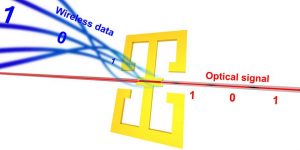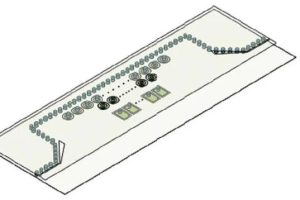
“Our modulator is completely independent of external power supplies and, on top of that, extremely small so that it can, in principle, be mounted on any lamppost. From there, it can then receive data via microwave signals from individual houses and feed them directly into the central optical fibre”, said scientist Yannick Salamin.
Less than 1mm across, the device (see diagram) is an antenna that receives mm waves and converts them into voltages across the thin slot at the centre of the chip – increasing field intensity 90,000 times, according to the paper ‘Microwave plasmonic mixer in a transparent fibre-wireless link‘, which describes the device in Nature Photonics. .
 Light from the fibre also impinges on the slot, which is a few μm wide and <100μm long.
Light from the fibre also impinges on the slot, which is a few μm wide and <100μm long.
“Inside the slit, the light propagates differently from the fibre optic cable or air,” said ETH, “no longer as an electromagnetic wave, but as a plasmon made of electromagnetic fields and oscillations of electric charge at the surface of a metal. Owing to this property, they can be confined much more tightly than light waves.”
A non-linear material within the slot allows the electric field to modulate the plasmons, affecting the way they are converted back to photons at the end of the slot.
Experiments at 60GHz demonstrated reception of 10Gbit/s over 5m and 20Gbit/s over one metre.
“The direct transfer from millimetre waves to light waves makes our modulator particularly versatile regarding the frequency and exact format of data encoding”, said Professor Jürg Leuthold of ETH Zurich, adding that the modulator is already compatible both with 5G technology and, as there are no electronics, can work even faster making it useful at 300GHz with transmission up to 100Gbit/s, and is CMOS-compatible.
EHZ Zurich worked with University of Washington in Seattle.
Street scene shows data transmitted by millimetre waves (red arrows) directly converted into optical pulses for fibre (yellow). Provided by ETH Zurich, attributed to Salamin Y et al. Nature Photonics 2018.
Device illustration attributed to ETH Zurich and Jürg Leuthold.
 Electronics Weekly Electronics Design & Components Tech News
Electronics Weekly Electronics Design & Components Tech News



